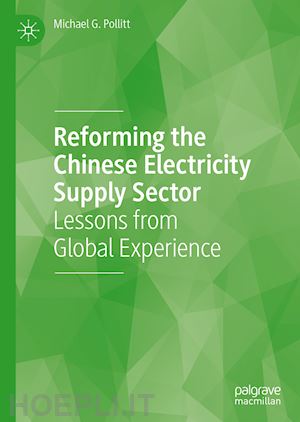
Questo prodotto usufruisce delle SPEDIZIONI GRATIS
selezionando l'opzione Corriere Veloce in fase di ordine.
Pagabile anche con Carta della cultura giovani e del merito, 18App Bonus Cultura e Carta del Docente
The Chinese electricity sector is the largest in the world, covering well over 20% of the world's electricity supply. While many other countries liberalized their electricity systems in the 1990s, thereby creating competitive wholesale and retail electricity markets, China’s move towards liberalization has advanced at a slower pace – until now.
Following the China State Council's publication of the No. 9 document on 'Deepening Reform of the Power Sector', this book reflects on the ambitious new round of reforms aimed at introducing competitive wholesale electricity markets and incentive regulation for its power grids. Written in collaboration with Hao Chen, Lewis Dale and Chung-Han Yang, this book provides lessons for China’s reforms from international experience, combining a detailed review of reforms from around the world with specific application to China and focuses on how the industrial price of electricity is determined in a liberalized power system.
Chapter 1: An Introduction to the Chinese Power System
This chapter would introduce the power system and discuss its scale and scope. We would document its size, carbon impact, renewables, demand structure and its significant companies. It would discuss the recent history of the sector and the background to the 2015 power sector reforms.
Chapter 2: Lessons for China from international experience of power sector reform (with Hao Chen and Chung-Han Yang)
This chapter would introduce and discuss 14 different electricity reform elements from international experience. Under each of these reform elements we discuss: its theoretical significance; general reform experiences with it; and its application in the Chinese context. Our motivation is how China might bring down the currently high industrial price of electricity. We identify four promising sources of price reduction: the introduction of economic dispatch of power plants; rationalisation of electricity transmission and distribution; reduction of high rates of investment; and rebalancing of electricity charges towards residential customers. We draw out some overall lessons and identify some important points for future research into Chinese power market reform.
Chapter 3: Power market reform in China - Lessons from Guangdong (with Hao Chen and Chung-Han Yang)
This chapter examines power sector reform in China’s largest province, Guangdong, following the publication of the No.9 document of the China State Council in March 2015. We look at the operation of the pilot wholesale power market in Guangdong in the light of international experience. We discuss how the power market pilot is working in Guangdong and the extent to which the current market design is in line with successful power markets we see elsewhere. We examine the evidence on whether the market reform has successfully brought new players into the electricity system in Guangdong. We consider the effects of the reform on the operational and investment decisions of firms in the sector. We conclude with several lessons for the Chinese government’s ongoing power sector reform programme.
Chapter 4: How the industrial power price is determined in a liberalized power market (with Lewis Dale)
In this chapter, we begin by discussing the components of the price of industrial electricity in Great Britain, as an example of a fully reformed electricity market, where the market is roughly comparable in size to a reasonably large Chinese province. We go on to discuss the key actors in the liberalized electricity system in Great Britain, before unpacking each of the components of the price. We discuss the market determined elements first, then go on to introduce and discuss the regulated elements of the price before finishing with the central government determined price components. Our discussion covers the determination of the wholesale price, the retail margin, transmission charges, system balancing charges, distribution charges and environmental levies and taxes. In each of these cases we discuss the process by which they are determined (led by the market, the regulator, the central government or more than one) and the specific lessons for China. We conclude by emphasizing some of the high-level lessons on electricity price determination for China.
Chapter 5: Prospects for Reform of China’s electric power sector
This chapter would briefly draw out the discuss reflections from the three previous chapters on the prospects for the reform. We would discuss the optimal sequencing of reform and reflect on the latest progress being made with the reform. We would organize the chapter around separately discussing key messages for Chinese policy makers, regulators, generators, retailers and grid companies involved with reform.
Michael G. Pollitt is Professor of Business Economics at the Judge Business School, University of Cambridge, UK. He is Assistant Director of the Energy Policy Research Group (EPRG), joint Academic Director of the Centre on Regulation in Europe (CERRE), and sits on the council of the International Association for Energy Economics (IAEE). He is one of Europe’s leading energy economists and has published extensively on the impacts of electricity reforms across the world.











Il sito utilizza cookie ed altri strumenti di tracciamento che raccolgono informazioni dal dispositivo dell’utente. Oltre ai cookie tecnici ed analitici aggregati, strettamente necessari per il funzionamento di questo sito web, previo consenso dell’utente possono essere installati cookie di profilazione e marketing e cookie dei social media. Cliccando su “Accetto tutti i cookie” saranno attivate tutte le categorie di cookie. Per accettare solo deterninate categorie di cookie, cliccare invece su “Impostazioni cookie”. Chiudendo il banner o continuando a navigare saranno installati solo cookie tecnici. Per maggiori dettagli, consultare la Cookie Policy.